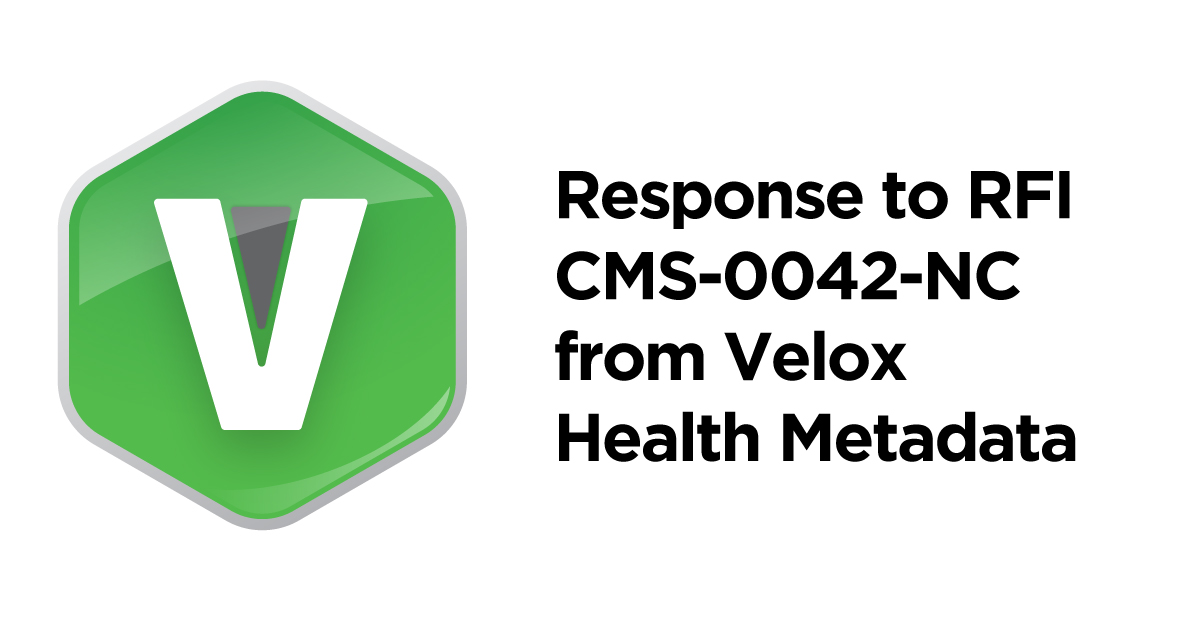Response to RFI CMS-0042-NC from Velox Health Metadata

Introduction
Velox Health Metadata, Inc. appreciates the opportunity to respond to the CMS Request for Information on the Health Technology Ecosystem. The response is informed by Velox’s expertise in interoperability (Clinical Data Exchange) and the leadership team’s significant experience with the Health Technology Ecosystem and various use cases, including quality reporting, risk adjustment, VBC and others.
Velox Background
Velox has been founded with the goal of making interoperability, or as we prefer to call it, Clinical Data Exchange, as seamless and fast as the Internet and as secure and reliable as online banking.
Our founding team has been working towards that goal for several years and believes that this goal is very much in reach, given developments in the standards and legislative arenas in the last 15 years, most notably with the emergence and adoption of HL7 FHIR® and the 21st Century Cures Act of 2016.
We are additionally encouraged towards our aim given more recent developments, including the themes of the questions in this RFI as well as the seemingly broad consensus in the recent listening session regarding this RFI on topics including a focus on API certifications.
Not only do we believe that such a modern, comprehensive, secure and real-time exchange of clinical data is possible on a national scale. More importantly, we have reasons to believe (and data to support) that such a clinical data ecosystem can transform numerous use cases that heavily depend on clinical data for all major stakeholders: patients, clinicians, provider systems, payers and government agencies at the federal and state levels.
The following sections provide a brief overview of Velox’ position on key topics recurring in this RFI:
Optimizing Interoperability/Clinical Data Exchange
We have concluded that the optimal way to exchange clinical data among stakeholders is via a federated, directory-facilitated clinical data ecosystem, where all requestors and data sources (systems of record) exchange data directly via FHIR APIs without intermediaries.
While data connections (point-to-point, networks and beyond) are an important foundation for optimal clinical data exchange, we have seen over and over, however, that use cases are patient- or member-centric. Our approach to solving interoperability fully takes that into account and we encourage CMS and the wider community of stakeholders to fully embrace this guiding principle, which obviously mirrors the desire to design many aspects of our healthcare system to become increasingly patient-centric.
Provider Directory
We fully support CMS’ goal to stand up a nation directory. Such a directory would ideally combine and improve NPPES and a national endpoint directory with NPI as a primary key to locating FHIR Endpoints. Velox has experience with this approach.
Patient Record Locator
The best way we believe a patient record locator to work is to inventory clinical events (patient encounters and others) as a way to link a provider (with the corresponding directory entry) and the patient (in the long run) with a national ID scheme, but for logistical reasons with best practice-based patient matching for the patient in the foreseeable future.
Such a metadata directory has several advantages, including the ability to quickly locate relevant clinical events for a patient (most use cases are patient centric, not endpoint/provider centric). It eliminates ‘broadcasting’ of queries for patient records to many endpoints or networks to locate relevant data. It only captures some limited amount of PII (no PHI) to accomplish an optimal way of locating patient records.
Other benefits of this approach include:
- No Aggregation of PHI
- No attack surface for clinical data breaches
- No single point of failure/chokepoint (federated model)
- No data transmission and translation errors
- Optimized data speed (usually real-time)
- Minimized costs
- Data source (system of record) remains in control of data sharing (intended use)
- Monetization remains in the control of the data source (to the extent allowed)
- Minimized overhead for data source
- Enables automated data provenance
Ensuring Data Quality
Clinical data is useful to the requestor if it is ‘complete’, which Velox defines as follows:
Data from all relevant clinical events for any combination of patient and use case are discovered and captured
Data for each event contains all data elements and context to fully satisfy the use case, i.e. data is ‘fit for purpose.’ To meet this need, clinical data exchange needs a standardized In that context, Velox supports and encourages the PIQI Framework which we understand is under consideration as a widely applicable standard for clinical data quality.
We also support USCDI as a good way to gradually enforce minimally available data. For USCDI to be optimal for enforcing minimally available data sets, it needs to continually be reconciled with FHIR resource definitions and, by extension, with mapping those resources to different use cases.
FHIR as a Universal Interoperability Standard
Velox is almost exclusively focused on accessing ‘complete’ clinical data for payers, providers and patients. We recognize that there are use cases (e.g. Prior Auth) that go beyond locating and accessing (read-only) clinical data. It is our informed opinion, however, that FHIR is also the best standard/technology for more transactional (read-write) use cases.
